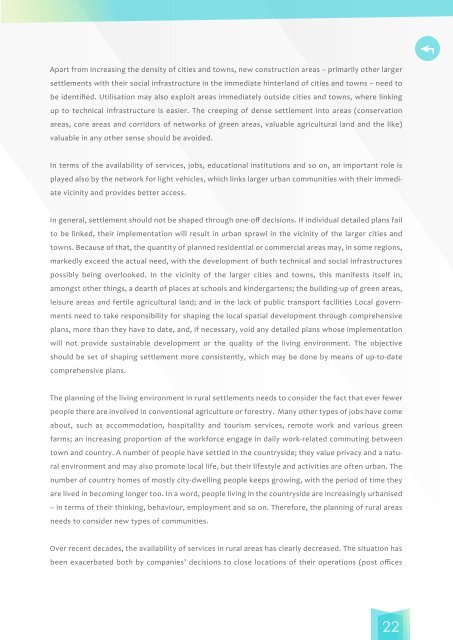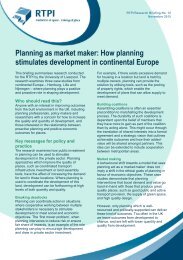estonia-2030_en
estonia-2030_en
estonia-2030_en
Create successful ePaper yourself
Turn your PDF publications into a flip-book with our unique Google optimized e-Paper software.
Apart from increasing the d<strong>en</strong>sity of cities and towns, new construction areas – primarily other largersettlem<strong>en</strong>ts with their social infrastructure in the immediate hinterland of cities and towns – need tobe id<strong>en</strong>tified. Utilisation may also exploit areas immediately outside cities and towns, where linkingup to technical infrastructure is easier. The creeping of d<strong>en</strong>se settlem<strong>en</strong>t into areas (conservationareas, core areas and corridors of networks of gre<strong>en</strong> areas, valuable agricultural land and the like)valuable in any other s<strong>en</strong>se should be avoided.In terms of the availability of services, jobs, educational institutions and so on, an important role isplayed also by the network for light vehicles, which links larger urban communities with their immediatevicinity and provides better access.In g<strong>en</strong>eral, settlem<strong>en</strong>t should not be shaped through one-off decisions. If individual detailed plans failto be linked, their implem<strong>en</strong>tation will result in urban sprawl in the vicinity of the larger cities andtowns. Because of that, the quantity of planned resid<strong>en</strong>tial or commercial areas may, in some regions,markedly exceed the actual need, with the developm<strong>en</strong>t of both technical and social infrastructurespossibly being overlooked. In the vicinity of the larger cities and towns, this manifests itself in,amongst other things, a dearth of places at schools and kindergart<strong>en</strong>s; the building-up of gre<strong>en</strong> areas,leisure areas and fertile agricultural land; and in the lack of public transport facilities Local governm<strong>en</strong>tsneed to take responsibility for shaping the local spatial developm<strong>en</strong>t through compreh<strong>en</strong>siveplans, more than they have to date, and, if necessary, void any detailed plans whose implem<strong>en</strong>tationwill not provide sustainable developm<strong>en</strong>t or the quality of the living <strong>en</strong>vironm<strong>en</strong>t. The objectiveshould be set of shaping settlem<strong>en</strong>t more consist<strong>en</strong>tly, which may be done by means of up-to-datecompreh<strong>en</strong>sive plans.The planning of the living <strong>en</strong>vironm<strong>en</strong>t in rural settlem<strong>en</strong>ts needs to consider the fact that ever fewerpeople there are involved in conv<strong>en</strong>tional agriculture or forestry. Many other types of jobs have comeabout, such as accommodation, hospitality and tourism services, remote work and various gre<strong>en</strong>farms; an increasing proportion of the workforce <strong>en</strong>gage in daily work-related commuting betwe<strong>en</strong>town and country. A number of people have settled in the countryside; they value privacy and a natural<strong>en</strong>vironm<strong>en</strong>t and may also promote local life, but their lifestyle and activities are oft<strong>en</strong> urban. Th<strong>en</strong>umber of country homes of mostly city-dwelling people keeps growing, with the period of time theyare lived in becoming longer too. In a word, people living in the countryside are increasingly urbanised– in terms of their thinking, behaviour, employm<strong>en</strong>t and so on. Therefore, the planning of rural areasneeds to consider new types of communities.Over rec<strong>en</strong>t decades, the availability of services in rural areas has clearly decreased. The situation hasbe<strong>en</strong> exacerbated both by companies’ decisions to close locations of their operations (post offices22




